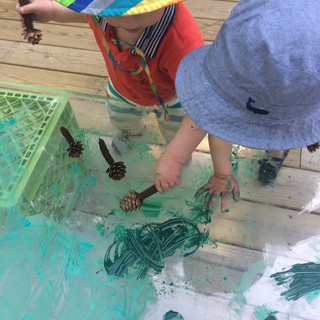Experiencing the Process of Art
- Care And Education Center

- May 18, 2018
- 2 min read
When you walk the halls of early childhood education centers and public schools you are often met with wall-to-wall artwork, all perfectly crafted with the same cut out shapes and/or messages. When I see these types of artwork I wonder: Where are the unique children behind this artwork? Were they able to express themselves? What did the experience look like as it unfolded? Did the children feel comfortable exploring on their own or was it heavily teacher-led?

Product Art, shown above, where children engaged in the experience have instructions to follow with a sample of what the end result is supposed to look like created by the far superior teacher, has a right and wrong way to be done. The adult has a finished product in mind, and the finished product all looks similar. Unfortunately, the children are often frustrated with these experiences, and the adult might "fix mistakes" leaving the children feeling defeated and incompetent. There is often not an ability to opt into the experience, as it is a structured time where all children take part in the experience at the same time.

I challenge you to take a moment to think about a different type of artwork, Process Art, where there are no step-by-step instructions and no sample of artwork for children to follow. When there is no right or wrong way to explore and create, the focus is on the experience and exploration rather than the outcome. Each child's art is unique and original, and the children often feel excited to create as they are relaxed and are not afraid of failure as the artwork is entirely their own. In this experience, the materials are set out so that the child has a choice to opt in or opt out and to join the experience when they would like. Children can then express their feelings, ideas and emotions. Process Art encourages children's creativity. The gallery of photos below is an example of something we have done. Please click the gallery below for details.
So, how can I plan Process Art experiences? Really, it's as easy as providing materials in a safe space where children can explore and use the materials when and how they want to without adult instruction or altering of their process or ideas, and without any intended or desired outcome (besides having fun creating and observing!)
Here are a few experiences we have provided. The objective is to explore the materials in a unhurried manner. Enjoyment of the process is valued and celebrated.
Something I learned while exploring Process Art:
We often ask children “What is it?” as a way to label their art. However, children assume, because they put their heart and soul into it, that you already know what it is! Instead, if you wanted to comment on their works of art, you may say, “Tell me about your creation” or ask, “What do you like best about what you created?” This builds their intrinsic confidence, learning they can create without judgement, and without a goal or focus to please others. It also opens the door for them to share the ideas behind their art and is a wonderful way of building expressive language skills.





















Comments